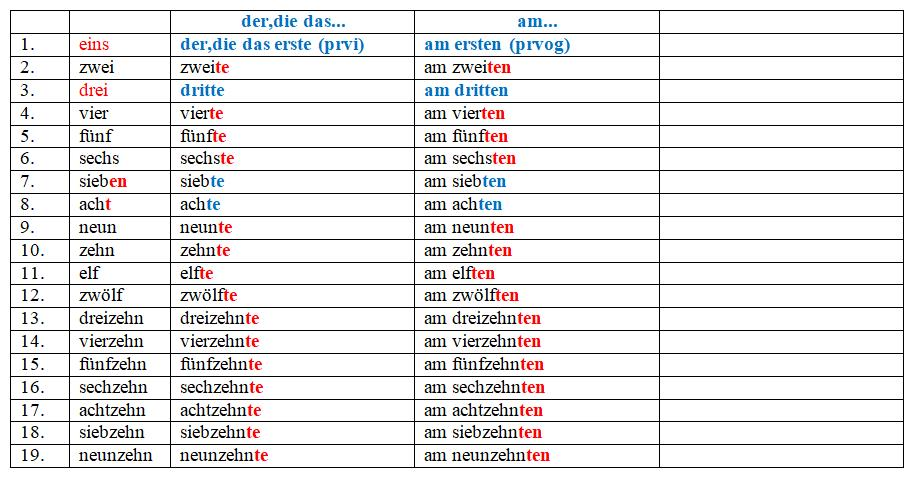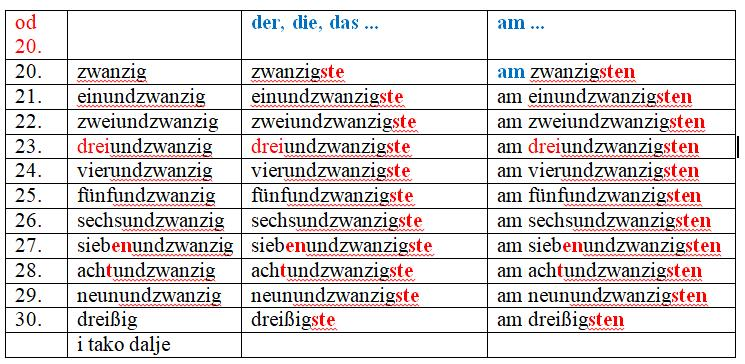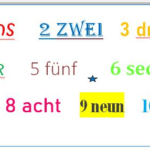In this lesson, you’ll learn how to form ordinal numbers in German (Ordilanzahlen or Ordnungszahlen). How they are declined and where and how they are used.
Thank you for reading this post, don't forget to subscribe!CONTENTS
What are ordinal numbers?
How do we build ordinal numbers?
Ordinal numbers from 1-19
Declinations and some other notes
Ordinal numbers from 20
How are ordinal numbers written?
Dates in German
How to pronounce the year in German
What are ordinal numbers?
When numbers become adjectives, they are called ordinal numbers. In English, the suffix -th is added to most numbers to make them ordinal numbers: for example, fifth, tenth, twentieth, and so on.
German does something similar: it adds the suffix -te to numbers up to nineteen and the suffix -ste to numbers over nineteen.
Ordinal numbers can be used for dates and enumeration. Depending on the nature of the text, we can write them as numbers, then put a period after the number or in letters as words.
For example:
Heute ist der 1. Mai 2022. (Today is May 1, 2022.)
Ich wohne im zweiten Stock. (I live on the second floor.)
How do we build ordinal numbers?
We usually use ordinal numbers with a definite article (der, die, das) and decline them as adjectives. Ordinal numbers are built by adding suffixes to basic numbers:
Ordinal numbers from 1-19
Ordinal numbers from 1-19 are formed by adding the suffix -te to the cardinal number. Exceptions are numbers one, three, seven, and eight.
For the numbers up to 20, the suffix -te is used:
der zweite (2nd) der zwölfte (12th) der fünfzehnte (15th)
There are three irregular forms:
der erste (1st) der dritte (3rd) der siebte (7th)

Click on:
Grammar Contents
Declinations and some other notes
Ordinal numbers are declined according to adjective declensions. They mark dates, months, and seasons; for the date, the day and month are marked with an ordinal number, and the year is marked with a cardinal number, that’s why there is no period after the year.
For example:
- Die Feier findet am Freitag, den 4. Juni 2022, um 16 Uhr, statt.
- Ich wohne im zweiten Stock.
- Mein Sohn ist in der siebten Klasse
All ordinal numbers can be used with zu and without the suffix – e: zu zweit, zu dritt … in the meaning: double, triple …
Wir leben zu viert in 2-Zimmer-Wohnung. ( Four of us live in a 2-room apartment.)
Wir lernen zu dritt. ( The three of us learn together.)
Ordinal numbers from 20
Ordinal numbers from 20 are built by adding the suffix -ste to the cardinal numbers. There are no exceptions here:

How are ordinal numbers written?
According to the rules of the new German orthography, ordinal numbers are written with a lowercase letter if a noun comes immediately after them, then they have the function of an adjective:
- Es war das erste Mal. (It was the first time.)
If the ordinal number is in the sentence, then it is written with a capital letter:
- Sie ging als Erste durchs Ziel. (The first one passed the goal.)
Ordinal numbers can be written as numbers followed by a period, and they can also be written as letters:
- 2. – der/ die/ das zweite
- 8. – der/ die/ das achte
Dates in German
How to read the date in German?
In German, the day (and sometimes the name of the month) is pronounced as an ordinal number, for example: 2. 2. 2022
We write the day as an ordinal number, that is, as a digit with a period. We can also write the month as an ordinal number or use the name of the month, for example: 2. Februar 2022
If we add the day of the week to the date, then the name of the month is most often written, for example: Montag, 2. februar 2022
- Welches Datum ist heute? (What date is today?)
Heute ist der vierte April.
Heute ist der vierte Vierte.
As you can see there are two ways to pronounce the date in German. We can specify the month or instead of the month a number, that number is then written with a capital letter.
For example:
- Wann sind Sie (formal) geboren? (When were you born?)
Ich bin am vierten April geboren.
- Wann bist du(informal) geboren? (When were you born?)
Ich bin am vierten Vierten geboren.
Click on:
Grammar Contents
How to pronounce year in German
In German, the year is not an ordinal number, so we do not put a period after it.
And it is read differently than in English: one thousand nine hundred
For example:
1999 – 19 HUNDERT 99 ( neunzehn-hundert-neunundneunzig)
1573 – 15 HUNDERT 73 ( fünfzehn-hundert-dreiundsiebzig)
From 2000:
2000 – 2 TAUSEND
2002 – 2 TAUSEND 2
If I were to answer the question: Wann sind Sie geboren?;
Complete answer would be: Ich bin am vierten April 1999 geboren.
- Wann bist du im Urlaub? (When are you on vacation?)
Von dem se stapa u vom. When we want to specify a specific period, we use the preposition von dem. We use dem because von always goes with the dative. Von dem merges into vom.
- Vom siebten bis (zum) vierzenten Juli.
See more:
Bis zum nächsten Mal!:)



